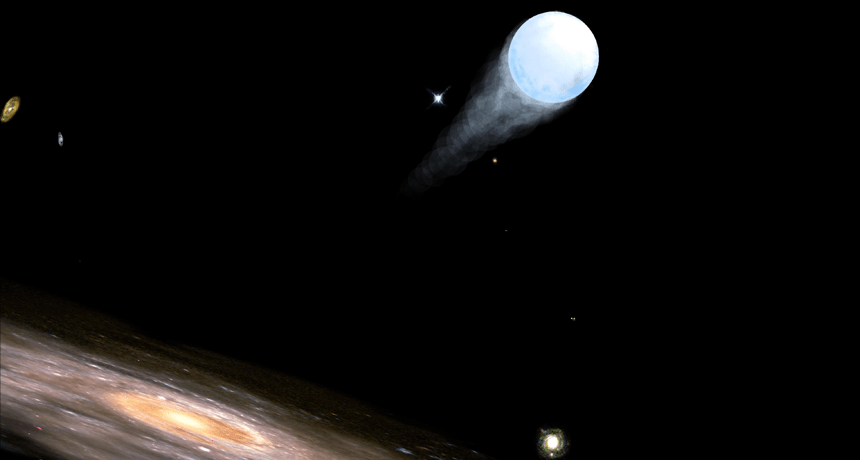Supernova hurls star out of the galaxy
US 708 is Milky Way’s fastest-moving stellar escapee

ON THE LOOSE Hypervelocity stars (one illustrated) travel so fast they can escape the galaxy. US 708 is the fastest known of this cohort, possibly ejected by a supernova explosion, astronomers say.
Ruth Bazinet, CfA
- More than 2 years ago
Some stars are in a rush to get out of the galaxy. One such star is hurtling away from the Milky Way at roughly 4.3 million kilometers per hour, researchers report in the March 6 Science, making it the fastest-moving star to be ejected from our galaxy.
The escapee, designated US 708, might have been propelled by a stellar explosion known as a type 1a supernova, suggest Stephan Geier, an astronomer at the European Southern Observatory in Garching, Germany, and colleagues. If their proposal is true, then astronomers could use stars like US 708 to probe the origin of type 1a supernovas, which are among the most powerful explosions in the universe.
US 708 is one of roughly a couple dozen hypervelocity stars, which travel so fast they can flee the galaxy. Researchers suspect that most hypervelocity stars are shot out of the Milky Way after a close brush with the supermassive black hole that sits in the center of the galaxy. Geier and colleagues, however, measured the speed and trajectory of US 708 and traced its path back to somewhere in the Milky Way’s disk, roughly 30,000 light-years from the galactic center.
The other known hypervelocity stars are pretty normal; they don’t look any different from the billions of other stars in the galaxy. But US 708, discovered in 2005, “has always been an oddball,” Geier says. The star has had most of its atmosphere stripped away, suggesting that it once had a very close companion.
That companion might have been a white dwarf, the core of a long-dead star, Geier says. While orbiting each other, the white dwarf might have stolen helium from US 708, eventually triggering an explosion that destroyed the white dwarf and flung US 708 out of the galaxy.
“That’s pretty remarkable,” says Warren Brown, an astronomer at the Harvard-Smithsonian Center for Astrophysics who in 2005 discovered the first known hypervelocity star. “You don’t normally think of supernovas popping off their companion stars at over 1,000 kilometers per second.”
Brown’s own research supports the conclusions of the new study. He used the Hubble Space Telescope to track the motion of 16 hypervelocity stars, including US 708. He and his colleagues report online February 18 at arXiv.org that US 708 was probably launched from the outskirts of the Milky Way. Although Brown’s team calculates that the star came from much farther out than Geier suggests, the basic conclusion is the same. US 708 “pretty clearly doesn’t come from the center of the galaxy,” Brown says.
Stars like US 708, which is about 28,000 light-years away in the constellation Ursa Major, could give researchers a better handle on exactly what causes type 1a supernovas. Currently astronomers can only observe a supernova after the fact and try to piece together what happened. “It’s like you have a crime scene,” Geier says. “Something killed the white dwarf and you want to figure it out.”
Two key pieces of forensic evidence are the mass of the white dwarf — which plays a role in how a white dwarf detonates and how quickly it and its neighboring star spin — and what type of companion it had. If US 708 is indeed fleeing from a supernova, astronomers have at least one example of an accomplice to the explosion and can use US 708’s speed to estimate the victim’s mass. Both clues can help researchers better understand how and why stars sometimes explode.







